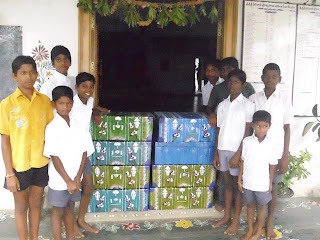Mahalakshmi Vrata or Varalaksmi Vratha is a sacred day in Hinduism. The ceremony is performed by married Hindu ladies on the Friday before the full moon in the month of Sravana in the Hindu calendar (corresponding to July/August in the western calendar). Those who cannot perform it on that day, can do it on any other Friday in that month This is an important Vratha, meaning a vowed religious observance in Sanskrit. Varamahalakshmi Vratha is performed more commonly in the southern Indian States of Andhra, Karnataka, Tamil Nadu and also in parts of Maharashtra and Orissa.
Puja is performed by married Hindu women to seek the blessings of the goddess Mahalakshmi, wife of Lord Vishnu, who is considered to be the abode of wealth and prosperity. There is a legend that says that this vratam was recommended by Lord Shiva to his wife Parvati to gain wealth and prosperity.[citation needed] There is also another legend that tells of a very pious lady Charumati who was asked by the goddess Varalakshmi, in her dream, to do the vratam in order to fulfill her wishes. She performed the vratam along with other ladies in her village with great devotion. They offered the deity lots of delicacies and once the vratam was completed, they were amazed to find their bodies decked with expensive jewels and their homes full of riches. From then on, women started performing this vratam every year seeking wealth and prosperity in their families.
On the day of Varalakshmi vratam, women clean their homes and decorate their front yards with rangolis (colorful designs traced on the floor). Later, they take a bath and deck themselves with beautiful clothes and jewellery. They then begin the process of performing the vrata by first arranging the kalasha or sacred pot. They fill the pot with rice and water which symbolize prosperity and cover it with mango and betel leaves. They then place a coconut smeared with turmeric and vermilion on the kalasha and also decorate the coconut with a new cloth. Some people decorate the kalasha with many kinds of jewels to make it look more beautiful. They place this kalasha on a plate filled with rice. The main puja begins by worshiping Lord Ganesha, who is believed to drive away all obstacles and evil forces. Later, goddess Mahalakshmi is invoked into the kalasha. They then worship a couple of torams (a bunch of nine threads with nine knots) and tie one to the kalasha while the other one is tied around the right hand wrist of the lady performing the pooja. Later, they chant the Lakshmi Ashtottara Shatanamam (a list of hundred names in praise of the deity). They then offer the goddess nine varieties of delicacies including both sweets and savories. In conclusion of the vratam, they sing hymns in praise of goddess Varalakshmi and also invite another married woman assuming her to be goddess Varalakshmi and offer her sweets. That evening, they invite all the neighboring laides to their homes and offer them tamboolam, an offering consisting of betel leaves, fruits, betel nuts, vermilion, turmeric and dakshina (money). They also collectively sing songs in praise of goddess Varalakshmi.









